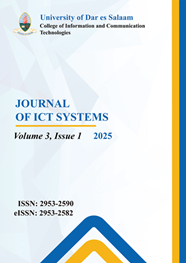Effects and Optimal Integration of Electric Vehicle Charging Systems in the Tanzania Electrical Distribution Networks using Metaheuristic Algorithms
Main Article Content
Abstract
Electric vehicles (EVs) present a viable solution for reducing carbon emissions, environmental pollution, and the effects of climate change. The EV utilizes energy stored in its battery banks, which are charged by electric vehicle charging systems (EVCS), primarily integrated with the power grid. However, integrating EVCS into grid poses significant challenges, including increased power losses, voltage deviations, harmonic injection, and grid instability. This study examines the impacts of connecting EVCS to Tanzania's electrical distribution networks and proposes an optimization approach using metaheuristic algorithms to mitigate power loss and voltage deviation challenges. The study reveals that adding one EVCS raises power loss from 13.0357 kW to 17.1963 kW, while voltage deviation increases from 0.47 V to 0.63 V, with further deterioration in system performance as more EVCS units are introduced. An enhanced Symbiotic Organism Search algorithm was employed to determine the optimal allocation and size of EVCS and PV systems. The results show that integrating 1 PV in the power system with 3 EVCSs reduced power loss to 5.26 kW from 61.42 kW. This research reveals the effectiveness of optimal PV system placement in improving the stability of the electrical network and the feasibility of an efficient EV penetration in Tanzania.
Article Details

This work is licensed under a Creative Commons Attribution-NonCommercial-NoDerivatives 4.0 International License.

